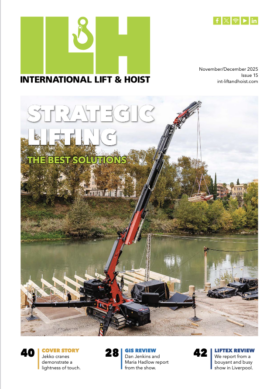Scotland’s 106-Year Old Titan Crane Designated International Historic Civil and Mechanical Engineering Landmark
The American Society of Civil Engineers (ASCE) has deemed the 106-year old Titan Crane at Clydebank an International Historic Civil and Mechanical Engineering Landmark–a designation given to the Eiffel Tower, the Sydney Harbor Bridge, and Machu Picchu.
The Titan is one of only 13 of its kind left in the world. It is only the fourteenth landmark in the UK to have received the ASCE accolade and the first in UK to be endorsed by four leading international engineering institutions—ASCE, the Institution of Civil Engineers (ICE), the American Society of Mechanical Engineers (ASME) and the Institution of Mechanical Engineers (IMechE).
Awarding the landmark designation, Andrew Herrmann, past president of ASCE, said: “The Titan Crane is a beacon among cranes as it influenced the development of many similar cranes across the globe. ASCE is honored to join for the first time with three other engineering societies to designate the Titan as an international historic engineering landmark.”
The Titan becomes the fifth internationally recognized engineering landmark in Scotland taking its place alongside the Forth Railway Bridge, the Forth & Clyde Canal, the Craigellachie Bridge, and the Caledonian Canal.
Constructed in 1907 at a cost of more than $38,400 the crane was designed by “engineer extraordinaire” Adam Hunter (1869 – 1933), a Scottish engineer from Glasgow based firm Sir William Arrol & Co and member of both the ASCE and ICE.
The innovative design of the crane, which included a fixed counterweight and electrically operated hoists, mounted on a rotated beam, made it faster and more responsive than its steam powered predecessors. On completion, the Titan was tested to lift loads of up to 160 tons. Hunter’s design later became the most widely adopted in the world, influencing the erection of cranes of this type worldwide.
The crane, now a unique visitor and education heritage center on the River Clyde, made a major contribution to Glasgow’s shipbuilding industry last century, helping to fit out some of the world’s biggest battleships and liners including the Queen Mary, Queen Elizabeth and the Queen Elizabeth 2.
A plaque was unveiled at a special ceremony at the Crane today to mark the designation.
In a special ceremony to mark the designation, Lyn Ryden, community board member of Clydebank Re-built and the Titan Clydebank Trust said: “Today’s designation of the Titan Clydebank as a world engineering landmark is a tremendous boost to our educational work here in promoting the proud heritage of shipbuilding and engineering on the Clyde.
“Thanks to the Titan’s lifting power, John Browns shipyards were able to build some of the biggest ships in the world last century. The Titan is now sadly all that remains of the shipyards at Clydebank but this award puts the Titan on the world engineering map for today’s visitors and future generations of young people.”
The nomination for the award to the Titan was put forward by the Institution of Civil Engineer’s Panel for Historical Engineering Works. ICE’s President, Professor Barry Clarke, said: “This award represents a significant achievement for what is a unique example of the longstanding history of civil engineering excellence in Scotland. Equally, it highlights the creativity and ingenuity of the engineers who contributed to its construction—traits which civil engineers all over the world display in their work to this day.”
ASME President, Madiha El-Mehelmy Kotb added: “The American Society of Mechanical Engineers is honored to be among the organizations recognizing the historical significance of the Titan Crane. The Titan is a mechanical as well as civil engineering marvel, incorporating electric motors and aspects of structural design that became models for future cranes.”
The structure has previously been awarded IMechE’s Engineering Heritage Award in 2012 and its restoration in 2007 was recognized by the Chicago Athenaeum Award for Architecture in 2008 and the Civic Trust Award in 2009.
Since 2007, more than 40,000 people, including many college and school children, have visited the Titan, taking the elevator to the top and learning more about Clydebank’s shipbuilding heritage. The Titan is open to the public during the summer months on Saturdays and Sundays or at any time by arrangement for community and school groups.











